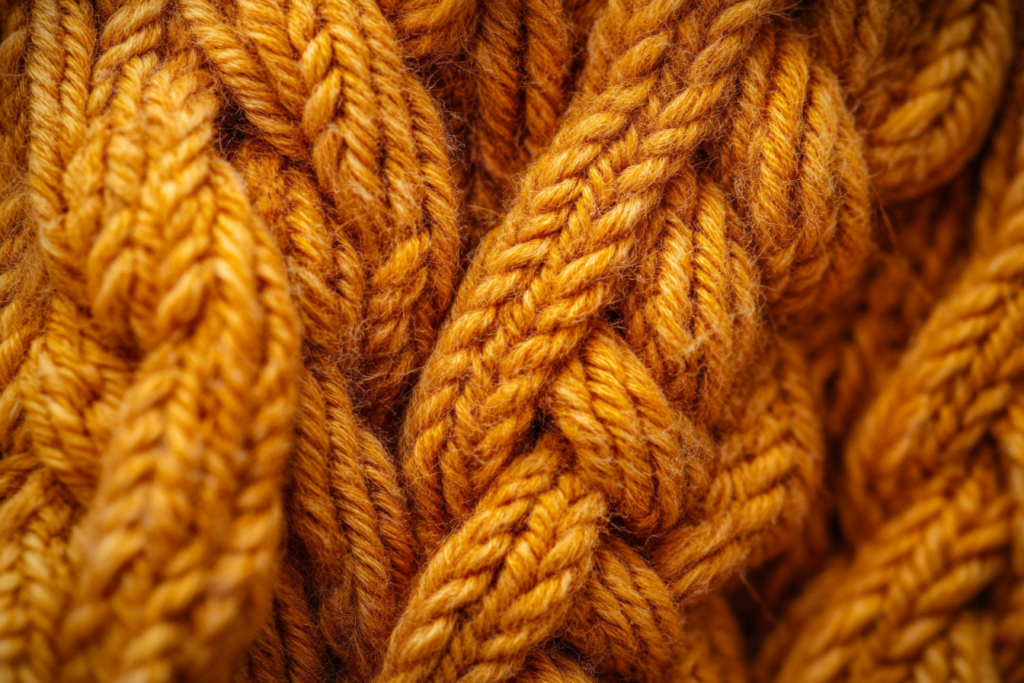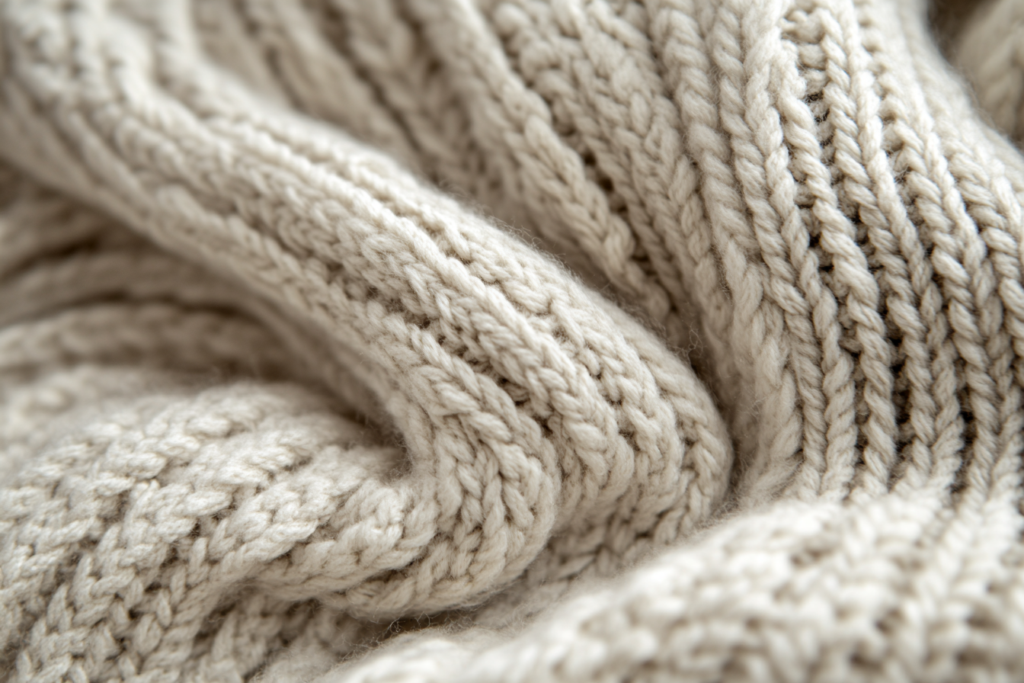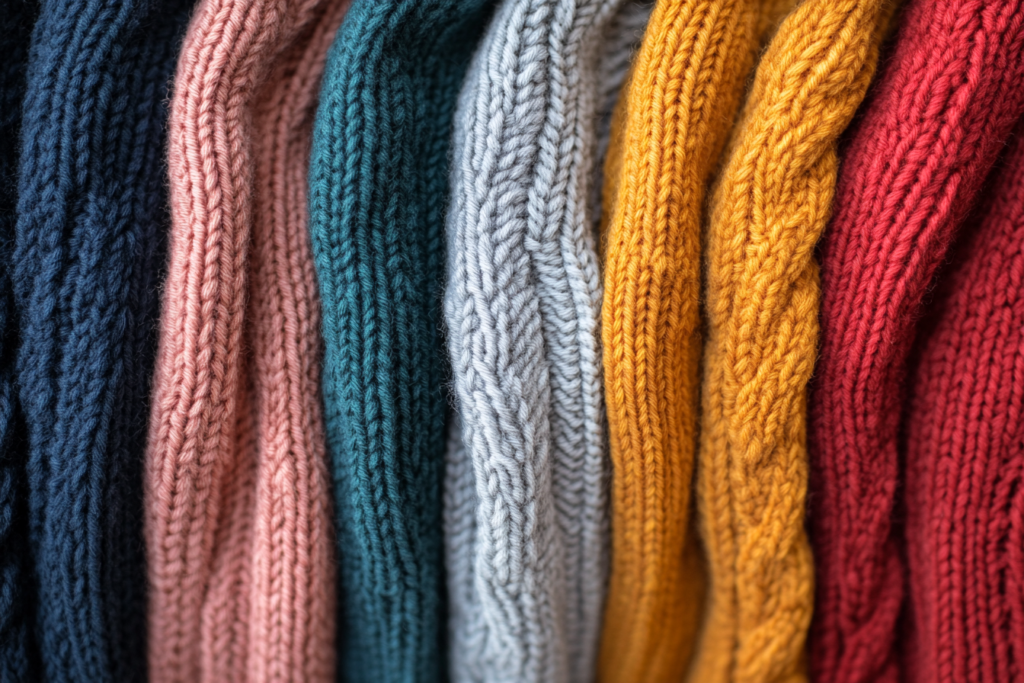Rib Knit Structure: The Versatile Fabric for Stretch and Comfort
Meta Description: Rib knit structure is a type of fabric known for its stretchy, textured pattern. Learn about its construction, benefits, and common uses in garments like sweaters and activewear.
What is Rib Knit Structure?
A rib knit structure refers to a type of knitted fabric where the pattern alternates between raised and recessed sections, creating a ribbed effect. This texture is achieved by using a purl needle on overlapping yarns, with the process requiring a double needle plate machine. The most common form of ribbing is the 1×1 rib, where a knit stitch (on the front) and a purl stitch (on the back) intersect, creating a fabric with distinct vertical ridges.
Rib knit fabrics are incredibly versatile and are widely used in both fashion and functional clothing due to their unique stretch and flexibility.


Key Features of Rib Knit Structure
✔ Stretch and Flexibility: The interlocking knit and purl stitches provide a significant amount of stretch and give, allowing the fabric to conform to the shape of the wearer’s body.
✔ Textured Appearance: The raised ribs on the surface of the fabric create a distinctive visual texture that can add a stylish, sophisticated touch to any garment.
✔ Durability: Rib knits are typically quite durable because the structure provides extra strength and resilience, making them well-suited for activewear or garments that need to withstand regular wear and tear.
✔ Comfort: The inherent elasticity of rib knit fabrics makes them highly comfortable to wear, as they allow for freedom of movement and are less prone to losing their shape over time.
✔ Double Needle Plate Machine: Rib knit fabrics are created on specialized machines that use two needles to interlock the yarns, resulting in a fabric with a smooth texture on the outside and a slightly looser knit on the inside.
Types of Rib Knit Structures
- 1×1 Ribbing The most common form of ribbing, the 1×1 ribbing alternates between one knit stitch and one purl stitch. It’s widely used in garments that require flexibility and stretch, such as sweaters, cuffs, and neckbands.
- 2×2 Ribbing In 2×2 ribbing, two knit stitches alternate with two purl stitches. This creates a thicker, more pronounced ribbing, and is often used for items like cuffs or waistbands, where a snug, firm fit is desired.
- 3×3 Ribbing For a more pronounced texture and stretch, 3×3 ribbing consists of three knit stitches alternating with three purl stitches. This type of ribbing is less common but is sometimes used for oversized sweaters or heavy-duty knitwear.
- Flat Ribbing In flat ribbing, the fabric is knitted without the usual stretch, giving it a flatter, more structured appearance. This type of rib knit is used in tailored garments or where minimal elasticity is needed.
Benefits of Rib Knit Structure
- Excellent Fit Rib knit fabrics are known for their ability to stretch and recover, which means they conform to the body’s shape and are particularly useful in creating fitted garments like sweaters, dresses, and athletic wear.
- Breathability and Comfort The knitted construction allows air to pass through the fabric, making it breathable and comfortable to wear for long periods. This is especially important in activewear and casual clothing.
- Flexibility and Movement Rib knit fabrics have significant stretch in both directions (width and length), making them ideal for garments that require mobility, such as sportswear, yoga pants, and comfortable everyday clothing.
- Durability The tight interlocking of the yarns in rib knit fabrics makes them resilient to wear and tear, providing long-lasting garments. This durability is beneficial for activewear and other high-use garments.
- Visually Appealing The raised texture of rib knit fabrics gives them a distinctive, stylish appearance that adds depth and interest to basic pieces like t-shirts, cardigans, and dresses.
Common Uses of Rib Knit Structure
📌 Sweaters and Cardigans Rib knit is often used in the construction of sweaters and cardigans, where the stretchy fabric helps the garment fit comfortably around the body, while the ribbing provides a structured yet flexible finish.
📌 Activewear and Sportswear Due to its flexibility and breathability, rib knit fabric is frequently used for activewear, such as leggings, sports bras, and yoga pants. The fabric moves with the body and provides excellent comfort during exercise.
📌 Cuffs, Waistbands, and Necklines Ribbed cuffs, waistbands, and necklines are popular in many casual and sports garments. The stretch of the rib knit allows these areas to fit snugly, providing both comfort and a secure fit.
📌 Casual and Everyday Garments The rib knit structure is also a go-to choice for casual and everyday clothing like t-shirts, tank tops, and dresses, thanks to its versatility, comfort, and stylish appearance.
How to Care for Rib Knit Fabrics
- Gentle Machine Wash: Rib knit fabrics can typically be machine washed, but it’s best to use a gentle cycle to preserve the elasticity and texture.
- Avoid High Heat: High temperatures can cause rib knit fabrics to lose their shape or shrink, so it’s important to avoid hot water and direct heat from drying.
- Flat Drying: To prevent stretching or distorting the shape of rib-knit garments, it’s recommended to lay them flat to dry.
- Use Mild Detergents: Harsh detergents can break down the fibers in rib knit fabrics, so using a mild detergent is recommended to maintain the fabric’s quality over time.
Conclusion: The Versatility of Rib Knit Structure
Rib knit fabrics are a staple in the fashion industry for their ability to offer both style and functionality. With their inherent stretch, texture, and comfort, rib knits are used in a wide variety of garments, from sweaters and cardigans to activewear and casual wear. Their durability and flexibility make them ideal for garments that need to maintain their shape while offering maximum comfort and movement. Whether you’re designing a chic sweater or a sporty set of leggings, rib knit structures provide the perfect balance of style, comfort, and performance.



